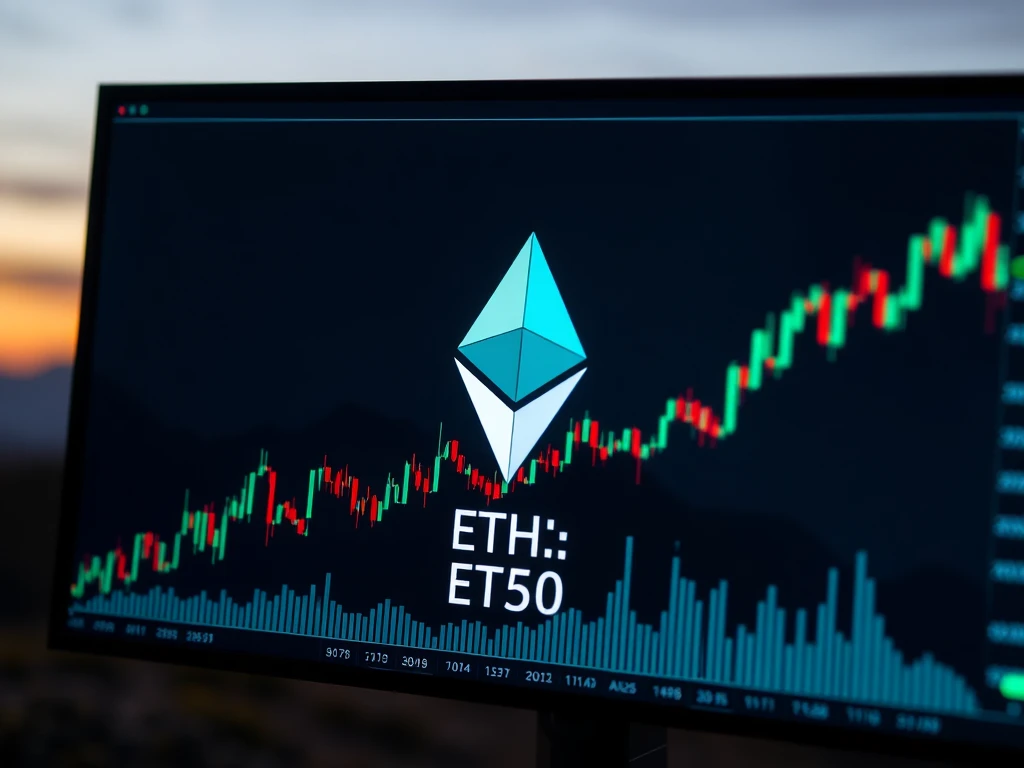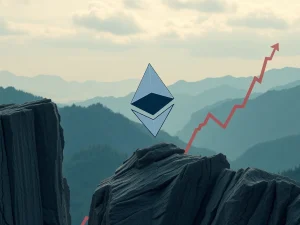Explosive Ether Price Rally: Will ETH Break $2,500?

Hey crypto enthusiasts! Have you been watching the charts? The Ether price is making some serious moves, climbing steadily and setting its sights firmly on the $2,500 mark. There’s a palpable sense of bullish momentum building around ETH right now, fueled by a confluence of technical indicators, growing interest via ETFs, and even whispers of capital shifting from Bitcoin. Let’s dive into what’s driving this potential breakout and whether ETH bulls have what it takes to push through that key resistance.
Why the Ether Price is Targeting $2,500
The current price action for Ether is painting a distinctly bullish picture. Looking at the market data, we see ETH price actively targeting liquidity pockets clustered just above the $2,500 level. These aren’t just arbitrary numbers; they represent areas where significant stop-loss orders might be sitting, making them attractive targets for market makers looking to fuel a move higher and potentially trigger short squeezes. The 2-week liquidation heatmap visually underscores this, showing these liquidity zones acting like magnets for the price.
From a technical perspective, the foundation for this upward push seems solid. ETH recently tested a crucial multimonth support zone between $2,100 and $2,200. The fact that this level held firm indicates robust buyer interest stepping in to defend the price. Adding to the bullish technical signals, the 3-day chart recently closed above $2,400, forming a ‘dragonfly doji’ candlestick pattern. This pattern, characterized by a long lower wick and a close near the high, often signals a potential reversal after a dip, showing that sellers were active early in the period but buyers ultimately took control.
Furthermore, the volume accompanying the price rise since May has been notably high, reaching levels not seen since the bear market period of July-August 2022. This surge in trading volume suggests renewed participation from both retail and institutional players, adding weight to the current rally. The liquidation heatmap reinforces this positive outlook, showing ETH consistently establishing higher lows above significant liquidation clusters, suggesting the path of least resistance remains upward.
Is Bitcoin Capital Rotation Fueling ETH’s Rise?
Could a significant factor behind the recent ETH price strength be a rotation of capital from Bitcoin? According to analysis from Swissblock, this appears to be a strong possibility. Their data points to what they term a ‘Zone 5’ accumulation phase for Ether, a period that has historically preceded significant upside moves for ETH. This phase aligns with several key factors seen in previous bull cycles, such as 2017 and 2021.
A key metric supporting this idea is the percentage of supply in profit for both BTC and ETH. Currently, over 90% of the Bitcoin supply is in profit. While this is great for existing holders, it can indicate limited immediate upside potential as more supply becomes available to sell. In contrast, Ether lags behind, with under 80% of its supply in profit. This lag is a recurring signal identified by Swissblock that suggests ETH is due for a ‘catch-up’ rally relative to Bitcoin. The ETH/BTC ratio also nearing multi-year lows further supports the idea that ETH might be undervalued compared to BTC, making it an attractive target for capital looking for potential higher returns.
This potential Bitcoin capital rotation narrative is gaining traction, especially as investors look for opportunities beyond Bitcoin after its significant run.
The Growing Influence of Ethereum ETF Inflows
Another powerful driver for the bullish sentiment around Ether is the noticeable increase in institutional interest, particularly through spot Ethereum ETF products. Recent data highlights a significant shift in capital flows between Bitcoin and Ethereum ETFs.
- In May, spot Bitcoin ETFs saw approximately $5.23 billion in inflows.
- In June, this dropped to around $2.64 billion, a decrease of nearly 50%.
- Conversely, spot Ethereum ETFs experienced a surge, with inflows increasing from roughly $564 million in May to $950 million in June.
- This represents a substantial 68.4% month-over-month growth for ETH ETFs.
This stark contrast, resulting in a 118% swing in the relative inflow ratio favoring ETH ETFs, strongly suggests that institutional capital is increasingly pivoting towards Ether. This growing institutional appetite, evidenced by the robust Ethereum ETF inflows, provides a significant tailwind for the ETH price and reinforces the bullish outlook presented by technicals and capital rotation theories.
What Are the Key Takeaways for the Current ETH Market?
Putting it all together, the picture for Ether looks promising. Here are the main points:
- Targeting Liquidity: ETH is actively pushing towards significant liquidity pools above $2,500, which could act as catalysts for further price appreciation.
- Strong Technicals: Key support levels are holding, and bullish patterns like the dragonfly doji suggest upward momentum is likely to continue. High volume confirms broader market interest.
- On-Chain Signals: Large withdrawals from exchanges indicate a potential shift from short-term trading to longer-term holding among some participants.
- Capital Rotation Potential: Swissblock’s analysis points to historical patterns suggesting ETH is poised to ‘catch up’ to Bitcoin as capital potentially rotates into lagging assets with higher profit potential.
- Institutional Interest: Surging inflows into spot Ethereum ETFs highlight growing institutional confidence and investment in ETH.
While the path to $2,500 and beyond involves navigating market dynamics, the current alignment of technical strength, on-chain activity, capital flow patterns, and institutional interest paints a compelling bullish scenario for the Ether price. The question isn’t just *if* it will reach $2,500, but *when* and *how far* it can run once it potentially breaks through.
As always, the crypto market carries risk, and it’s crucial to conduct your own research before making any investment decisions. This article provides market analysis based on available data and trends.









